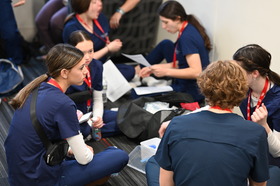Ethics in Medicine
Lesson Topic:
Ethical considerations and standards in healthcare
Lesson Description:
This lesson is focused around a case study created by Julia Omarzu with the Department of Psychology at Loras College in Dubuque, Iowa. The case study addresses the moral, ethical, and medical issues surrounding the treatment for a young girl suffering from a rare genetic disorder called Fanconi anemia. The case study is written as a scripted discussion between medical and biotechnology professionals in regards to the processes, risks, and ethical concerns surrounding the use of genetic diagnosis, stem cells, and in-vitro fertilization. Students will be asked to respond to the ethical issues from the perspective of one of the seven characters from the case study as well as share their personal opinions.
This resource is adapted from the "Ethics in Medicine" resource by Josh Olson, found on the California Educators Together website.
Learning Goals/Outcomes:
- Students will be able to properly identify and explain how biotechnology is used in medicine to address genetic disorders and address infertility.
- Students will address how professional, institutional and personal ethics are challenged in regards to gentic manipulation and popular medical practices.
Nebraska Standards:
HS.HS.6.2 Describe legal and ethical standards of healthcare.
Teacher Planning:
Materials Needed:
- A computer and projector to show the short video clip.
- Electronic or Print copies of the resources listed below.
Time Required for Lesson:
55 minutes
Diagram/Setup:
Ability to divide students into six character groups for the initial discussion, followed by new groups of six each for the group discussion.
Instructional Plan:
Anticipatory Set/Pre-Activity:
Begin the class with the trailer for "My Sister's Keeper." After the clip is over, ask the students to discuss what they saw. The discussion will vary. Facilitate any reasonable thoughts and collect them to address later.
Real-World Connection:
Medical decisions are often fraught with ethical choices and varying perspectives. In this lesson, students consider and debate a case around a real disorder, Fanconi anemia.
Activities (i.e. instructions, warm-up, lesson, cool-down):
Character Group Discussion:
Students should read the Fanconi anemia case study, taking notes and writing down questions. Once the case study/skit is completed and students have had a chance to complete their notes and write down any questions, divide students into six character groups: mother, father, Sally (the child with Fanconi anemia), the potential invitro embryos, the stem cell specialist, and Dr. Wagner, the pre-implantation genetic diagnosis specialist.
Once divided into the 6 separate character groups (i.e. all the mothers together, all the fathers together), students will address the moral, ethical and medical concerns they have about the procedures mentioned in the case study. Students should try to come to a consensus as to how they think their assigned character would proceed concerning the ethical issues surrounding the mentioned procedure.
During this time, the teacher should be moving around the room helping direct discussion. For example, the father group may not be considering the financial or emotional aspects of such an undertaking, or how the "unborn embryos" may feel knowing they are being engineered for "parts."
Integrated Group Discussion:
Once the 6 character groups have had enough time to come to an informed opinion, divide them into groups of 6 so that each group has one person from each character group. Have the students write down and discuss the opinions of each "character." During this time, some students will need to be reminded that they must only share the opinion that they came up with as the character. They will be given a chance to voice their personal opinions later.
Closure:
Character Letter:
Students are asked to articulate and write down the character's opinions. Assessment for this assignment should be based on the information that backs up the opinion. The second question is to compare how the character opinion and their personal opinion may differ.
Formative Assessment :
Character vs. Personal Ethics:
At this point students will be given a chance to vote on a series of yes/no questions as their character and then personally. Allow time for the students to discuss how they came to their consensus.
Supplemental Information:
If students are not used to conducting group discussions, it will be helpful to the lesson to establish some routines and expectations around group work and group discussions.
Modifications:
For students needing a shorter case study, highlight the most important points in the case study to direct their reading. A text-to-speech tool could also be helpful, as would small-group reading of the case study.
Safety Precautions:
No physical safety concerns are associated with this lesson.
